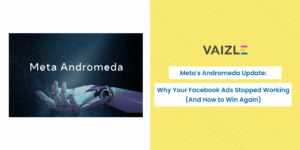Meta Ads Now Have a New Performance Goal: “Maximize ROAS”
Meta just added a new performance goal: Maximize ROAS. Should you use it? Here’s what changes and how to test it safely.
Meta rolled out a new performance goal for advertisers: “Maximize ROAS.” It’s a shift from how the platform has been optimizing campaigns for years. Until now, Meta focused on getting you the most conversions or the highest revenue within your budget.
With this update, the algorithm changes its approach entirely. It now prioritizes conversions that give you the best return on every dollar you spend, not just the most sales or the biggest revenue numbers.
So, if you’re selling products with different profit margins or price points, this changes how you should think about setting up and measuring your campaigns.
Here’s what’s different, how it works, and whether it makes sense for your business.
What Actually Changed in Meta’s Optimization Logic?
Before this update, you likely used the performance goal called “Maximize Value of Conversions.” That told Meta to go out and get you as much revenue as possible for your budget.
Sounds good, right? But it didn’t account for how much you were spending to get that revenue. You might get $10,000 in sales, but if you spent $8,000 to get there, your profit margin is tight. The algorithm wasn’t weighing cost against value in a meaningful way.
Now with “Maximize ROAS” (Return on Ad Spend), Meta’s system now evaluates each potential conversion based on its value relative to what it costs to acquire. It looks for conversions that bring in strong returns, even if that means fewer purchases overall.
Here’s a practical example. Let’s say you sell both phone cases ($25) and laptops ($900). Under the old system, Meta might’ve prioritized phone cases because they convert quickly and add up to a high number of total sales. But under Maximize ROAS, if laptop buyers give you better returns after factoring in costs, the algorithm will aim for those high-value buyers — even if it means lower total conversions.
To summarize in one line: Meta’s goal has now shifted from volume to efficiency.
When You Shouldn’t Use “Maximize ROAS” for Meta Ads?
Maximize ROAS isn’t the right fit for every campaign, and trying to force it where it doesn’t belong will hurt your performance. There are a few situations where you should stick with your current optimization goal instead.
- You’re launching a new product.
Meta doesn’t have historical data to work with. Start with “Maximize Conversions” or “Maximize Value” to build signal first. - You’re selling a single product with one price.
If every conversion is worth the same, ROAS targeting adds no advantage over standard conversion optimization. - You’re running brand awareness campaigns.
ROAS only works when conversions have measurable value. Don’t use it for reach or engagement campaigns. - Your value tracking isn’t set up properly.
Check Ads Manager. If your “Purchase Conversion Value” column is showing blank or wrong data, Meta can’t optimize properly. Fix tracking first.
Keep Track of ROAS With Vaizle AI
Switching to Maximize ROAS is a smart move when you’re aiming for better returns, but the real work starts after that. You need to keep an eye on what’s actually happening inside your campaigns.
Vaizle AI makes that part easier.
Once your Meta Ads account is connected, you can ask questions like:
- “What’s my average ROAS this week compared to last week?”
- “Which campaigns got better after switching to Maximize ROAS?”
- “Where am I spending too much without getting enough return?”
You’ll get answers in plain language, based on real data. No more digging through columns or second-guessing what’s going wrong.
Try it out and start tracking what actually drives your returns.
Get the latest marketing news and trends
Delivered straight to your inbox.
Thank you for subscribing!
Stay tuned for the latest updates.
Google has moved its newest AI agents from keynote slides into the...
For years, new ChatGPT models were sold on raw power: more context,...
For most founders, marketers, and small teams, turning a website into a...
Instagram is making it easier for businesses and creators to understand how...




